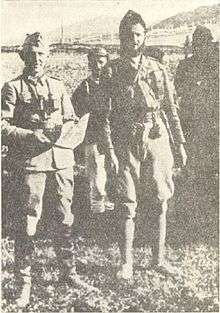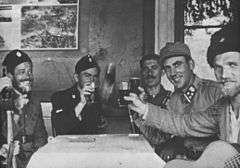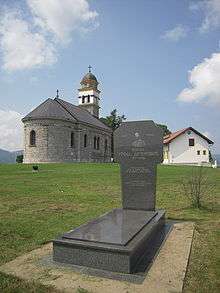Uroš Drenović
| vojvoda Uroš Drenović | |
|---|---|
 Drenović (on the right), alongside a German officer | |
| Native name | Урош Дреновић |
| Born |
11 November 1911 Sitnica, Condominium of Bosnia and Herzegovina, Austria-Hungary |
| Died |
29 May 1944 (aged 33) Banja Luka, Independent State of Croatia |
| Place of burial | Klisina Monastery, Prijedor |
| Allegiance |
|
| Commands held |
|
| Battles/wars | |
| Awards | |
Uroš Drenović (Serbian Cyrillic: Урош Дреновић; 11 November 1911 – 29 May 1944) was a Bosnian Serb military commander in the Central Bosnia region of the Independent State of Croatia (NDH) during World War II. Following the German-led Axis invasion of Yugoslavia in April 1941, he joined the Yugoslav Partisans and distinguished himself during the initial uprising against NDH authorities by capturing Mrkonjić Grad in August 1941.
Drenović subsequently led Serb-chauvinist agitation within the Partisan 3rd Krajina Detachment. After some vacillation, he eventually sided with the royalist Chetniks and became a Chetnik commander (vojvoda). In April 1942, he was defeated by the Partisans and fled to Banja Luka, where he concluded an alliance with the Ustaše to fight the Partisans. He continued to oppose the Partisans until his death during an Allied bombing raid on Banja Luka in May 1944.
Early life
Uroš Drenović was born in Sitnica, Ribnik near Mount Manjača in 1911. He finished teachers' college in Sarajevo,[1] and became a schoolmaster in the Banja Luka area.[2][3] Prior to the outbreak of the war, he was a reserve officer in the Royal Yugoslav Army (Serbo-Croatian: Vojska Kraljevine Jugoslavije, VKJ).[4]
World War II
Bosanska Krajina uprising
A matter of months after the German-led invasion of Yugoslavia in April 1941, uprisings began to occur throughout the newly created Axis puppet state, the Independent State of Croatia (Serbo-Croatian: Nezavisna Država Hrvatska, NDH).[5] On 4 July, the Communist Party of Yugoslavia (Serbo-Croatian: Komunistička partija Jugoslavije, KPJ) decided to launch a general uprising against the occupying forces across Yugoslavia, and rebellion broke out in Bosnia on 27 July.[6] This included local uprisings in southwest Bosnia, which spread across the NDH, but the KPJ organisation was initially swept along rather than leading the rebellion.[5]
On 29 August, Drenović distinguished himself by planning and leading the capture of Mrkonjić Grad by the rebels, but when the town was recaptured by NDH forces four days later, the KPJ blamed him and his troops, citing their poor discipline and anti-Muslim chauvinism.[7] In September, four battalions of fighters were formed in the Ribnik, Janj and Pliva region. One of these, the 3rd "Petar Kočić" Battalion, was commanded by Drenović, who, unlike the other battalion commanders in the region, did not allow the KPJ to appoint political commissars to his companies.[8] In an area largely free of KPJ activity, but under the sway of the sectarian Serb elite of Mrkonjić Grad, Drenović arrested Muslim communists in the area, even confronting senior members of the Partisan staff for Bosanska Krajina.[3]
On 26 September 1941 at Stolice in German-occupied Serbia, the Partisan leadership decided to standardise its military organisation across occupied Yugoslavia. As result, during October and November, three detachments were formed in the Bosanska Krajina from existing units such as the 3rd "Petar Kočić" Battalion, and Drenović was appointed as deputy commander of the 3rd Krajina Detachment responsible for the territory of central Bosnia. This region had strong pro-Chetnik currents, and of the 34 companies in the detachment, only 13 had KPJ organisations, only 11 had commanders that were members of the KPJ, and only 18 had a political commissar. Many KPJ activists in the region were Muslims or Croats, not easily accepted by the mass of the rank-and-file who were Serb-chauvinist peasants. Drenović himself was the leading exponent of Chetnik ideology in Central Bosnia. He despised Muslims and Croats but, according to the historian Marko Attila Hoare, was "diplomatic enough to keep his feelings in check when necessary".[9] In October, the Staff of the 3rd Krajina Detachment attempted to win over the Muslim village of Crljeni by gaining the agreement of the headman to contribute five armed men to the detachment. When the headman reneged on the deal, the bulk of the detachment attacked the village, but the rest of the detachment had to prevent Drenović's battalion from burning and looting it.[10]
On 26 November 1941, at a meeting of the Staff of the 3rd Krajina Detachment, Drenović advocated collaboration with the Italian occupation forces on the basis that the Italians were protecting Serbs from the Ustaše. This was rejected by the senior KPJ members of the staff, but they were not in a position to force him to abandon the idea. At the same meeting, Drenović refused to commit the 3rd "Petar Kočić" Battalion to fight the Italians. Under pressure, he agreed to advise neighbouring battalions if the Italians moved through his territory. In return, the Staff of the 3rd Krajina Detachment agreed that Drenović could refer to his force as a "Military-Chetnik Detachment".[7] On 10 December, the senior KPJ members of the 3rd Krajina Detachment concluded that 50 percent of their command staff did not support the leading role of the KPJ in the uprising. The Partisan staff for Bosanska Krajina later observed that the Staff of the 3rd Krajina Detachment had made no effort to remove Chetnik elements from its ranks or stop their Serb-chauvinist agitation.[7] In early February 1942, Drenović took a leading role in a conference intended to bring the 7th Glamoč Battalion, which had declared itself as "Chetnik", back into the Partisan structure. Drenović argued for the Chetnik side, and was expelled from the meeting along with his supporters, and the battalion returned to the fold.[11] On 6 February, a meeting of the leaders of the 1st, 2nd and 4th battalions of the 3rd Krajina Detachment met and decided to bring Drenović back into the Partisan movement by organising an attack on the Italian and Ustaše garrison of Mrkonjić Grad. Under pressure from his own rank-and-file, Drenović formally participated in the attack, but he was able to prevent its success through allowing the Italians to move past his battalion and attack the Partisan rear. According to Partisan sources, he forewarned the Italians and Ustaše forces, and divulged the Partisan plan to them.[12]
Alliance with the NDH

In response to highly effective pro-Chetnik agitation from within, many Partisan units defected to the Chetniks. In the second half of April 1942, the Partisans responded with aggressive military action against the defectors. The unit that led this offensive was the Grmeč Shock Anti-Chetnik Battalion, formed earlier that month from wholly loyal and reliable troops. This offensive spelt the end of Drenović's "Petar Kočić" Chetnik Detachment, and Drenović took refuge with the Ustaše in Mrkonjić Grad.[13] On 27 April, he and other defeated Chetnik commanders signed an agreement with the NDH. The agreement had eight points, requiring that hostilities between the Ustaše and Drenović's Chetniks come to an end, that NDH forces protect Serb villages from the Partisans and that Ustaše units assist the Chetniks in fighting the Partisans.[14][15] The agreement also required the Ustaše to restore religious and civil rights to Serbs of the Krajina. In turn, Drenović issued a declaration in which he recognized the sovereignty of the NDH.[16] Historian Enver Redžić argues that the agreement was reached out of military and political necessity.[17] He writes: "The Ustaše–Chetnik accords were driven neither by a confluence of Serbian and Croatian national interests nor by mutual desire for acceptance and respect, but rather because each side needed to obstruct Partisan advances. The Ustaše and Chetniks, two long-time foes, sought help from one another at a time when the Ustaše were facing national political disgrace among the Croats and the Chetniks were losing the support of the Serbs."[18]

The NDH authorities considered that the alliance would mean that the Chetniks could continue to subvert Partisan units. On 30 April, the NDH authorities recognised the rights of Drenović and his troops to remain armed in order to fight the Partisans.[13] The agreement between the NDH and Drenović's Chetniks was soon made public by the entire Ustaše press;[19] Serb public opinion remained divided.[20] By May, Drenović had a force of about 350 Chetniks.[21] At mid-month, he signed an agreement with a Croatian general staff officer in Banja Luka agreeing to cooperate with the NDH in fighting the Partisans.[16] Drenović soon emerged as one of the most important Chetnik leaders in western Bosnia.[22] That summer, when order had been established in significant parts of the Italian occupation zone, Drenović and other Chetnik detachment leaders and their principal political spokesmen with Italian Second Army headquarters were recognized by the Italians as auxiliaries and early in the summer Italian commander Mario Roatta allowed for the delivery of arms, munitions, and supplies to the Chetniks.[22] Other Chetnik leaders in Bosnia who had concluded alliances with the NDH by June 1942 included Mane Rokvić, Branko Bogunović, Stevo Rađenović and Momčilo Đujić. Historian Sabrina P. Ramet observes that this co-operation must be seen as a function of their mutual fear of the Partisans, and emphasizes the uncertainty and distrust that accompanied it.[23] By June, Drenović's Chetniks numbered about 600 men.[21]
In 1943, Drenović was awarded the Order of Karađorđe's Star by King Peter, based on a recommendation by Chetnik leader Draža Mihailović.[19] Following the Italian capitulation, Drenović agreed to all the actions of his Chetniks being performed in close cooperation with local German units, and was informed at the end of the year that Ustaše units would again be stationed in Serb-inhabited areas.[24] In October 1943, a team from the 1st Battalion of the 4th Brandenburg Division under Oberleutnant Hermann Kirchner began working alongside Drenović's Chetniks in northwest Bosnia, operating forward reconnaissance groups and developing contact with anti-communist farmers to keep an eye on Partisan troop movements.[25] There were about 950 Chetniks serving under Drenović that year, positioned around Manjača and Glamoč.[26] Drenović had about 400 Chetniks under his command by the following year. His was the only Chetnik band that the Ustaše trusted fully during the war.[27] According to BN Televizija, Drenović is considered a Chetnik vojvoda.[28]
Death
On 29 May 1944, Drenović was killed in an Allied bombing raid on Banja Luka.[29] The Ravna Gora Movement and Serbian Orthodox Church in Klisina organise a ceremony each year to commemorate Drenović's actions in 1941. In 2014, the ceremony was not attended by any officials of the Republika Srpska entity of Bosnia and Herzegovina, or by any representatives of the Prijedor municipality.[28]
Footnotes
- ↑ 24sata.info 21 July 2009.
- ↑ G-2 (PB) 1944, p. 37.
- 1 2 Hoare 2006, p. 102.
- ↑ Trikić & Repajić 1982, p. 21, note 15.
- 1 2 Hoare 2006, p. 76.
- ↑ Tomasevich 1975, p. 134.
- 1 2 3 Hoare 2006, p. 250.
- ↑ Hoare 2006, pp. 76–78.
- ↑ Hoare 2006, pp. 248–249.
- ↑ Hoare 2006, p. 251.
- ↑ Hoare 2006, pp. 252–253.
- ↑ Hoare 2006, p. 254.
- 1 2 Hoare 2006, pp. 261–262.
- ↑ Christia 2012, p. 206.
- ↑ Barić 2011, p. 182.
- 1 2 Milazzo 1975, pp. 78–79.
- ↑ Christia 2012, pp. 206–207.
- ↑ Redžić 2005, p. 88.
- 1 2 Dedijer 1990, p. 17.
- ↑ Hoare 2013, p. 170.
- 1 2 Milazzo 1975, p. 80.
- 1 2 Milazzo 1975, p. 77.
- ↑ Ramet 2006, p. 129.
- ↑ Milazzo 1975, p. 164.
- ↑ Greentree 2012, p. 17.
- ↑ Redžić 2005, p. 236.
- ↑ Tomasevich 1975, p. 354.
- 1 2 BN Televizija 2014.
- ↑ Hoare 2013, p. 254.
References
Books
- Barić, Nikica (2011). "Relations between the Chetniks and the Authorities of the Independent State of Croatia, 1942–1945". In Ramet, Sabrina P.; Listhaug, Ola. Serbia and the Serbs in World War Two. London: Palgrave Macmillan. pp. 175–200. ISBN 978-0-230-27830-1.
- Christia, Fotini (2012). Alliance Formation in Civil Wars. Cambridge, New York: Cambridge University Press. ISBN 978-1-107-02302-4.
- Dedijer, Vladimir (1990). The War Diaries of Vladimir Dedijer. 2. Ann Arbor, Michigan: University of Michigan Press. ISBN 978-0-47210-109-2.
- Greentree, David (2012). Knight's Move: The Hunt for Marshal Tito, 1944. Oxford: Osprey Publishing. ISBN 978-1-78096-461-4.
- Hoare, Marko Attila (2006). Genocide and Resistance in Hitler's Bosnia: The Partisans and the Chetniks, 1941–1943. New York: Oxford University Press. ISBN 978-0-19-726380-8.
- Hoare, Marko Attila (2013). Bosnian Muslims in the Second World War. Oxford: Oxford University Press. ISBN 978-0-231-70394-9.
- Milazzo, Matteo J. (1975). The Chetnik Movement & the Yugoslav Resistance. Baltimore, Maryland: Johns Hopkins University Press. ISBN 978-0-8018-1589-8.
- Ramet, Sabrina P. (2006). The Three Yugoslavias: State-Building and Legitimation, 1918–2005. Bloomington, Indiana: Indiana University Press. ISBN 978-0-253-34656-8.
- Redžić, Enver (2005). Bosnia and Herzegovina in the Second World War. Abingdon-on-Thames: Frank Cass. ISBN 978-0-7146-5625-0.
- Trikić, Savo; Repajić, Dušan (1982). Proleterski bataljon Bosanske krajine. Belgrade: Vojnoizdavački zavod. OCLC 441716267.
- Tomasevich, Jozo (1975). War and Revolution in Yugoslavia, 1941–1945: The Chetniks. Stanford, California: Stanford University Press. ISBN 978-0-8047-0857-9.
Documents
- G-2 (PB) (1944). "The Četniks: A Survey of Četnik Activity in Yugoslavia, April 1941 – July 1944". Caserta, Italy: Allied Forces Headquarters.
News
- BN Televizija (21 July 2014). Ravnogorsko prelo na Manjači [Ravna Gora at Manjača]. BN Televizija (in Serbian). Retrieved 29 September 2014.
- 24sata.info (21 July 2009). Manjača: Održan pomen četničkom vojvodi Urošu Drenoviću [Manjača: Commemorative ceremony held for Chetnik vojvoda Uroš Drenović] (in Serbian). Retrieved 13 September 2015.